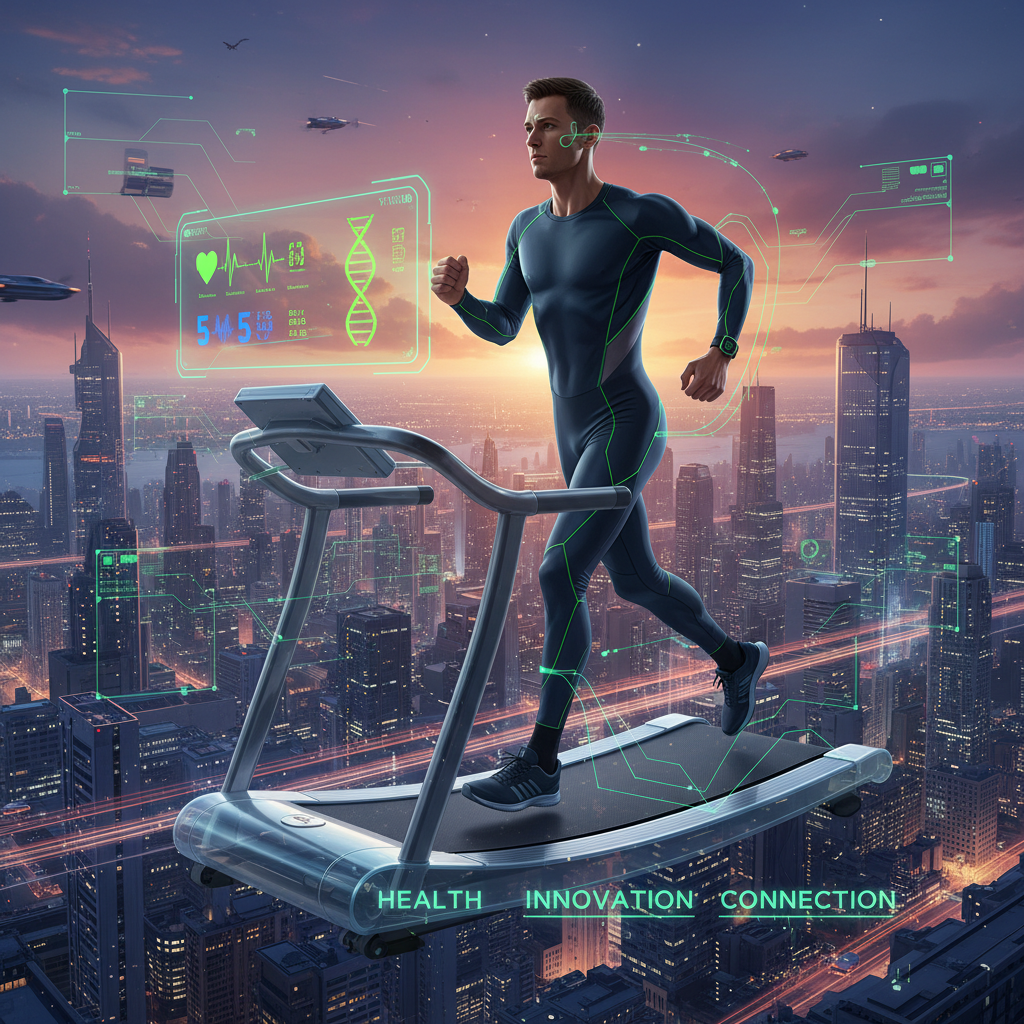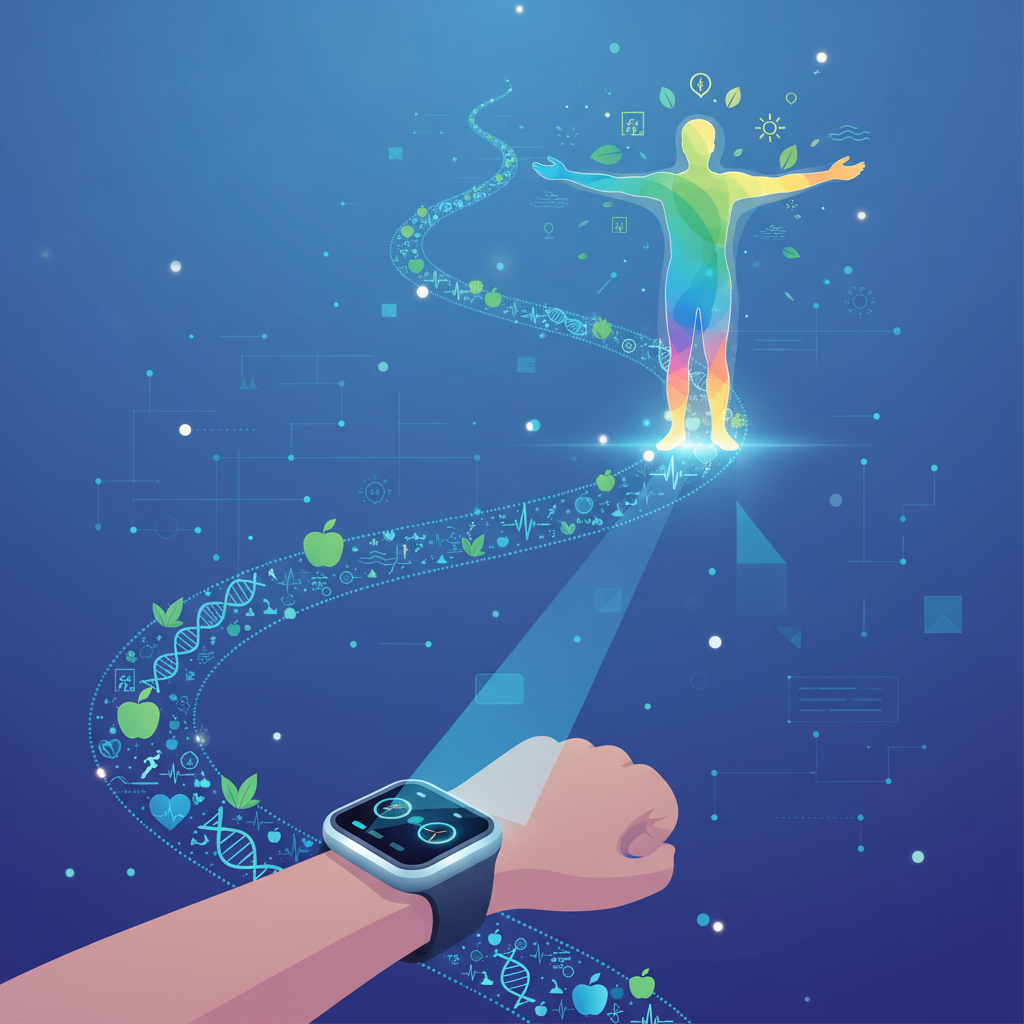
Beyond Your Wrist: How Wearable Tech is Revolutionizing Health and Fitness
Beyond Your Wrist: How Wearable Tech is Revolutionizing Health and Fitness

In an era defined by rapid technological advancement, the lines between our digital and physical selves are increasingly blurred. From the smartphones in our pockets to the smart homes we inhabit, technology has seamlessly integrated into nearly every facet of modern life. Yet, perhaps one of the most profound and personal transformations is occurring directly on our bodies: the rise of wearable technology. What once seemed like science fiction is now an everyday reality, with devices ranging from fitness trackers and smartwatches to sophisticated wearable health devices now commonplace.
These innovative gadgets have moved far beyond merely counting steps. Today, they are powerful, miniature health hubs, continuously collecting vital biometric data wearables and offering unparalleled insights into our well-being. This article will delve deep into how wearable tech is not just a trend but a fundamental shift, revolutionizing health and fitness by empowering individuals, aiding healthcare professionals, and paving the way for a truly personalized health future. We’ll explore the evolution, impact, current applications, future trends, and the myriad wearable technology benefits that are reshaping how we approach our health journey.
The Evolution of Wearable Technology: From Pedometer to Personalized Health Hub
The concept of wearing technology isn’t entirely new. Early iterations, like simple pedometers, have existed for decades, offering a basic count of physical activity. However, the last two decades have witnessed an explosion in complexity and capability. The advent of miniature sensors, improved battery life, and powerful processing chips led to the birth of the modern fitness tracker. These initial devices, popular in the late 2000s, revolutionized personal fitness by making activity tracking accessible and engaging.
The real game-changer arrived with the proliferation of smartwatches. Merging the functionalities of a smartphone with a traditional timepiece, smartwatches quickly became a central pillar of wearable technology. They integrated advanced wearable sensors capable of monitoring a vast array of physiological metrics, transforming a simple accessory into a comprehensive digital health companion. This evolution marked a significant leap, shifting the focus from mere activity logging to holistic health monitoring, laying the groundwork for the profound impact of wearables on health we see today.
Unpacking the Power of Wearable Health Devices
Modern wearable health devices are incredibly diverse, each designed to capture specific aspects of our health and activity. Understanding their capabilities is key to appreciating their revolutionary potential.
Fitness Trackers & Smartwatches: Your Daily Health Companions
At the forefront of the wearable technology revolution are fitness trackers and smartwatches. These devices have become indispensable for millions, offering a constant stream of information about our bodies and lifestyles.
- Activity Tracking: Beyond basic step counting, modern fitness trackers accurately measure calories burned, distance traveled, and active minutes, providing a comprehensive overview of daily physical activity.
- Exercise Recognition: Many devices can automatically detect and log various forms of exercise, from running and cycling to swimming and strength training, offering detailed metrics like pace, elevation, and repetitions for sports performance wearables.
- Sedentary Reminders: Counteracting the detrimental effects of prolonged sitting, these wearables gently prompt users to move throughout the day, promoting a more active lifestyle.
- Stress Monitoring: Utilizing heart rate monitoring devices and heart rate variability (HRV) data, many smartwatches can detect periods of elevated stress, often offering guided breathing exercises to help users relax.
- Sleep Tracking Technology: Perhaps one of the most valued features, sleep tracking technology analyzes sleep stages (REM, deep, light), duration, disruptions, and overall sleep quality, helping users understand and improve their nocturnal health.
- Heart Rate Monitoring: Continuous heart rate monitoring devices provide crucial insights into cardiovascular health, tracking resting heart rate, workout intensity, and even detecting irregular heart rhythms that could indicate underlying conditions.
![]()
These devices, integrated with robust mobile health apps, transform raw data into actionable insights, making them truly invaluable health and fitness gadgets.
Beyond the Wrist: Emerging Wearable Forms
While smartwatches dominate the market, wearable technology is rapidly diversifying beyond the wrist, offering new form factors and specialized functionalities.
- Smart Rings: These discreet devices pack powerful wearable sensors into a minimalist design, offering continuous heart rate monitoring devices, sleep tracking technology, activity tracking, and even payment capabilities, all from a finger.
- Smart Clothing: Embedded with advanced wearable sensors and biometric data wearables, smart clothing can monitor everything from muscle activity and posture to breathing patterns and core body temperature. This smart clothing represents a seamless integration of tech into our daily attire, with applications spanning athletic performance and medical monitoring.
- Hearables: Beyond traditional headphones, hearables are evolving to include sophisticated health monitoring features, capable of tracking heart rate, activity, and even acting as discreet hearing aids or offering real-time health coaching.
- Augmented Reality Wearables: Though still in nascent stages for mainstream fitness, augmented reality wearables (like smart glasses) hold immense potential for interactive workouts, virtual coaching, and real-time performance overlays, merging the digital and physical training environments.
Wearable Sensors: The Data Revolution
The magic behind these devices lies in their array of wearable sensors. These tiny components are constantly collecting a wealth of biometric data wearables, transforming it into meaningful health insights.
- Accelerometers and Gyroscopes: These are the workhorses for activity tracking, detecting movement, orientation, and impact, allowing devices to count steps, track sleep, and recognize different exercises.
- Optical Heart Rate Sensors (Photoplethysmography - PPG): Found in most smartwatches and fitness trackers, these sensors use LEDs to detect blood flow changes under the skin, accurately measuring heart rate.
- Electrocardiogram (ECG) Sensors: More advanced wearable medical devices include ECG capabilities, allowing users to record an electrocardiogram from their wrist, which can detect signs of atrial fibrillation (AFib) and other heart rhythm irregularities.
- Skin Temperature Sensors: Some devices now incorporate skin temperature tracking, which can provide insights into sleep quality, menstrual cycles, and even early signs of illness.
- Blood Oxygen (SpO2) Sensors: These measure oxygen saturation levels, offering crucial data, especially for sleep apnea detection or monitoring respiratory conditions.
The continuous flow of information from these wearable sensors forms the bedrock of modern digital health, enabling unprecedented levels of personal insight and preventative care.
The Impact of Wearables on Health: A Holistic Approach
The profound impact of wearables on health extends far beyond personal fitness goals. These devices are reshaping our approach to preventative care, chronic disease management, and even mental well-being.
Preventative Health Tech & Early Detection
One of the most significant wearable technology benefits is its role in preventative health tech. By continuously monitoring various health metrics, wearables can identify subtle changes or potential issues before they escalate into serious conditions.
- Identifying Abnormal Heart Rhythms: Features like ECG and continuous heart rate monitoring can alert users to potential signs of conditions like atrial fibrillation (AFib), prompting them to seek medical attention. Early detection is crucial for managing such conditions and preventing more severe outcomes like stroke.
- Monitoring Vital Signs for Early Warning: Consistent tracking of resting heart rate, heart rate variability, and even skin temperature can act as an early warning system, indicating potential illness or stress.
- Encouraging Healthy Habits: By providing real-time feedback and setting achievable goals, wearables motivate users to adopt healthier lifestyles, reducing the risk of developing chronic diseases such as type 2 diabetes, obesity, and cardiovascular issues. This proactive approach is central to preventative health tech.
- Personalized Health Insights: The constant stream of biometric data wearables allows for highly personalized health insights. Users can identify patterns related to their diet, exercise, and sleep that impact their well-being, enabling them to make informed choices tailored to their unique physiology.
Chronic Disease Management & Remote Patient Monitoring
For individuals managing chronic conditions, wearable health devices are truly transformative. They bridge the gap between doctor visits, providing continuous data that empowers patients and aids healthcare providers. This is where remote patient monitoring truly shines.
- Continuous Glucose Monitoring (CGM): For individuals with diabetes, continuous glucose monitoring (CGM) patches and integrated smartwatches have revolutionized glucose management. They eliminate the need for frequent finger pricks, providing real-time glucose levels and trends, which allows for better diet, exercise, and medication adjustments.
- Blood Pressure Monitoring: While wrist-based blood pressure monitors are still evolving for accuracy, some wearable medical devices are integrated with cuffs or use advanced algorithms to track blood pressure trends, offering valuable data for hypertension management.
- Oxygen Saturation Tracking: For conditions like asthma, COPD, or sleep apnea, SpO2 monitoring during sleep can provide critical data, helping patients and doctors understand symptom severity and treatment effectiveness.
- Reducing Hospital Visits: Remote patient monitoring enabled by wearable health devices allows healthcare providers to remotely track patients’ vital signs and symptoms, potentially reducing the need for frequent in-person appointments and hospital readmissions, especially for the elderly or those in rural areas.
- Role of Wearable Medical Devices in Clinical Settings: Beyond consumer-grade devices, specialized wearable medical devices are increasingly used in clinical trials and for specific medical conditions, providing highly accurate, continuous data for diagnosis and treatment.

These connected health devices are fundamentally altering the landscape of chronic disease management, moving towards a more proactive, data-driven, and patient-centric model. For more on cutting-edge tech, check out our insights on Mastering Generative AI Art: Tools, Trends, and Creative Futures.
Mental Health Wearables: Tracking Stress and Promoting Well-being
The conversation around health is incomplete without addressing mental well-being. Increasingly, wearable technology is playing a role in this vital area, offering insights into stress levels and promoting mindfulness. These are truly emerging mental health wearables.
- Heart Rate Variability (HRV) as an Indicator of Stress: HRV, the variation in time between heartbeats, is a key indicator of autonomic nervous system activity. Lower HRV often correlates with higher stress, while higher HRV suggests better resilience. Many smartwatches track HRV, offering a physiological window into stress levels.
- Guided Breathing Exercises: When high stress is detected, many wearable health devices offer guided breathing exercises directly on the device, providing immediate tools for relaxation and stress reduction.
- Sleep Quality Impact on Mental Health: Poor sleep is intrinsically linked to mental health issues. By providing detailed sleep tracking technology data, wearables can help users identify sleep patterns that contribute to anxiety or depression, encouraging better sleep hygiene.
- Integration with Mobile Health Apps for Mindfulness: The data collected by wearables can be integrated with mobile health apps that offer mindfulness exercises, meditation guides, and cognitive behavioral therapy (CBT) programs, creating a holistic approach to mental well-being.
Digital Health & Personalized Wellness: The Future is Now
The convergence of wearable technology, artificial intelligence, and robust data platforms is ushering in an era of truly personalized health and digital health ecosystems.
AI in Wearables: Smarter Insights, Tailored Advice
The sheer volume of biometric data wearables generate would be overwhelming without intelligent processing. This is where AI in wearables becomes indispensable.
- Predictive Analytics: AI algorithms can analyze long-term data trends to predict potential health issues, such as the likelihood of developing certain conditions or identifying periods of increased vulnerability to illness.
- Personalized Fitness and Nutrition Recommendations: AI can tailor workout plans, dietary advice, and recovery protocols based on individual performance, physiological responses, and goals, making fitness truly personalized health.
- Anomaly Detection: AI excels at identifying subtle deviations from a user’s baseline, alerting them to unusual heart rate patterns, sleep disturbances, or activity changes that might warrant attention.
- Learning User Behavior Patterns: Over time, AI in wearables learns individual habits, preferences, and physiological responses, making the insights and recommendations increasingly accurate and relevant. For more on AI’s potential, explore Unlock Your Potential: Top AI Tools for Everyday Productivity.
Connected Health Devices & Ecosystems
The vision of digital health is a seamless ecosystem where all our connected health devices work in concert.
- Integration with Electronic Health Records (EHRs): The ultimate goal is for wearable medical devices and consumer wearables to securely feed relevant data into a patient’s EHR, providing doctors with a more complete, real-time picture of their patients’ health.
- Seamless Data Flow Between Devices and Platforms: Data from your smartwatch, smart scales, and other health and fitness gadgets can be consolidated into a single mobile health app or platform, offering a unified view of your well-being.
- The Rise of Health Data Platforms: Dedicated platforms are emerging that aggregate, analyze, and visualize health data from multiple sources, providing users and healthcare providers with powerful tools for management and insights.
The Power of Personalized Health
At its core, the revolution of wearable technology is about personalized health.
- Tailoring Health Goals and Interventions: Gone are the days of one-size-fits-all health advice. Wearables provide the data needed to customize fitness routines, dietary plans, and wellness strategies to an individual’s unique needs, genetic predispositions, and lifestyle.
- Empowering Individuals to Take Control: By demystifying complex physiological processes and providing clear, actionable data, wearables empower individuals to become active participants in their own health journey, fostering a sense of ownership and responsibility over their well-being.

Wearable Tech Trends 2024 and Beyond: Glimpses into the Future
The pace of innovation in wearable technology shows no signs of slowing down. Looking ahead to wearable tech trends 2024 and beyond, we can anticipate even more sophisticated, integrated, and impactful developments.
Miniaturization and Integration
Future wearables will likely become even smaller, less obtrusive, and more seamlessly integrated into everyday items. Think about more advanced smart rings with even greater functionality or almost invisible wearable sensors embedded in everyday objects.
Advanced Biometric Data
Expect to see wearables capable of tracking an even wider array of biometric data, possibly including non-invasive blood pressure, hydration levels, continuous core body temperature, and even advanced biochemical markers, moving towards truly comprehensive biometric data wearables.
Augmented Reality Wearables in Fitness
The convergence of augmented reality wearables with fitness could create immersive training experiences. Imagine AR glasses projecting virtual coaches, overlaying performance metrics onto your field of vision during a run, or guiding you through complex exercises with real-time feedback.
Smart Clothing & E-textiles
Smart clothing will evolve beyond current prototypes, becoming indistinguishable from regular garments while offering continuous, comfortable monitoring of posture, muscle fatigue, and physiological stress, making health tech truly invisible.

Preventative Health Tech Focus
The emphasis on preventative health tech will intensify. Future wearables will be even better at predicting health risks, offering highly personalized preventative interventions, and working more closely with healthcare systems to provide proactive care, shifting from reactive treatment to proactive wellness.
Ethical Considerations and Health Data Privacy Wearables
As wearable technology becomes more integrated into our health, discussions around health data privacy wearables and ethical considerations will become paramount.
- Importance of Data Security: Ensuring the robust security of sensitive health data will be a top priority for manufacturers and service providers.
- User Control Over Health Data: Users will demand greater transparency and control over who accesses their health data and how it is used.
- Regulatory Frameworks: Governments and health organizations will continue to develop and refine regulatory frameworks to protect user privacy and ensure responsible data handling.
These developments will ensure that the future of wearables is not only technologically advanced but also ethically sound.
Choosing the Best Fitness Wearables and Health & Fitness Gadgets
With the market flooded with an array of health and fitness gadgets, selecting the right one can be daunting. Here are some factors to consider when looking for the best fitness wearables:
- Features: What specific metrics do you want to track? (e.g., advanced sleep tracking technology, ECG, continuous glucose monitoring, GPS).
- Accuracy: While consumer devices are not medical-grade, research user reviews and independent tests for accuracy, especially concerning heart rate monitoring devices and step counts.
- Battery Life: Consider how frequently you’re willing to charge your device.
- Ecosystem: Does the device integrate well with your smartphone, other connected health devices, and mobile health apps?
- Price: Wearables range from budget-friendly fitness trackers to premium smartwatches and specialized wearable medical devices.
- Comfort and Style: Since you’ll be wearing it often, ensure it’s comfortable and aesthetically pleasing.
- Specific Needs: Are you an athlete seeking detailed sports performance wearables data, someone managing a chronic condition needing remote patient monitoring, or just looking for general wellness tracking?
By carefully considering these factors, you can find the wearable technology that best supports your individual health and fitness journey. For broader sustainable tech, see our guide on Sustainable Smart Home: Energy-Saving Gadgets for a Greener Life.
Conclusion
The journey of wearable technology from simple step counters to sophisticated health tech hubs marks a revolutionary chapter in our pursuit of well-being. These ingenious devices, whether they are advanced smartwatches, discrete smart rings, or cutting-edge smart clothing, are fundamentally reshaping our understanding and management of health and fitness.
The wearable technology benefits are clear: empowering individuals with real-time biometric data wearables, fostering preventative health tech, enabling efficient remote patient monitoring, and paving the way for truly personalized health. With AI in wearables constantly evolving and new wearable sensors emerging, the future of wearables promises even greater integration and more profound impacts on our lives. From managing chronic conditions with continuous glucose monitoring to enhancing athletic performance with sports performance wearables, these connected health devices are more than just gadgets; they are catalysts for a healthier, more informed future.
Embrace the revolution beyond your wrist. Start exploring how wearable technology can transform your personal health and fitness journey today. For more insights into how technology is changing our world, visit HyperDaily’s blog at https://hyperdaily.one/blog/.
FAQs
Q1. What are the main benefits of using wearable technology for health and fitness?
Wearable technology offers numerous benefits, including real-time tracking of physical activity, sleep patterns, and heart rate; early detection of potential health issues; enhanced motivation for fitness goals; personalized health insights; and improved management of chronic conditions through continuous monitoring.
Q2. How accurate are fitness trackers and smartwatches for health monitoring?
While not medical-grade devices, modern fitness trackers and smartwatches are generally quite accurate for common metrics like step counting, heart rate, and sleep tracking for most users. Advanced features like ECG and SpO2 are increasingly accurate, but always consult a medical professional for critical health decisions.
Q3. Can wearable devices really help with preventative health?
Yes, wearable health devices are powerful tools for preventative health tech. By continuously monitoring vital signs and activity, they can identify subtle changes or anomalies that might indicate emerging health risks, encouraging users to adopt healthier habits and seek early medical advice, potentially preventing serious conditions.
Q4. What is continuous glucose monitoring (CGM) and how do wearables facilitate it?
Continuous glucose monitoring (CGM) involves wearing a small sensor that measures glucose levels in interstitial fluid throughout the day and night. Many modern smartwatches and dedicated CGM devices can display this real-time data, helping individuals with diabetes manage their blood sugar levels more effectively and make informed decisions about diet and activity.
Q5. How do wearables contribute to remote patient monitoring?
Wearable medical devices play a crucial role in remote patient monitoring by continuously collecting vital biometric data wearables from patients at home. This data, which can include heart rate, blood pressure, oxygen saturation, and activity levels, is securely transmitted to healthcare providers, allowing them to monitor patient health, manage chronic conditions, and intervene proactively without the need for constant in-person visits.
Q6. What role does AI play in the future of wearables?
AI in wearables is transforming raw data into actionable insights. AI algorithms enable predictive analytics for health risks, offer personalized health recommendations for fitness and nutrition, detect anomalies in health patterns, and learn user behavior to provide increasingly tailored and intelligent guidance, shaping the future of wearables.
Q7. Are there concerns about health data privacy with wearable devices?
Yes, health data privacy wearables are a significant concern. The vast amount of sensitive personal health data collected by wearables necessitates robust security measures and clear privacy policies. Users should be aware of how their data is collected, stored, and shared, and manufacturers are working to implement stronger encryption and give users more control over their information.
Q8. What are some of the latest wearable tech trends in 2024?
Wearable tech trends 2024 include increased miniaturization of devices (like advanced smart rings), enhanced AI in wearables for predictive insights, greater integration of augmented reality wearables for fitness, the rise of smart clothing for seamless monitoring, and a continued focus on preventative health tech and mental health wearables.